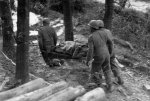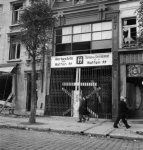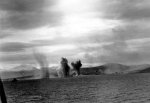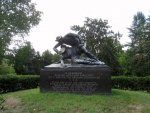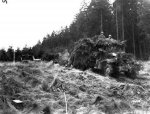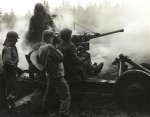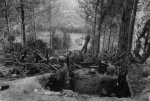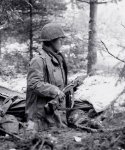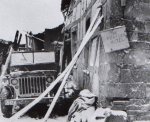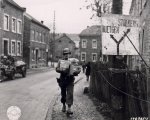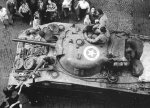The problem is that, of the infantry who've gone on record and who've served both in the open and in the Hürtgen basically say "anywhere but there." One major complaint was that the Germans knew where the Americans were, mostly, but the reverse was not true because of the peculiar topography of the forest. The Germans caused some out and out routs of American troops by proving to them that they knew exactly where their foxholes were by doing rolling artillery barrages marching right down the trenches.I will freely confess the light infantryman's preference for close terrain. The tough bit for the infantry, any infantry, is the last 300 meters. Look at the background of the photos Brad has posted and you can see only about 150 meters, so for half that distance attacking infantry is concealed by forest. Of course that cuts both ways, counterattacking German forces are also concealed until they are close t defending American troops.
What I think really made the Hürtgen bad for the American troops was the German troop density.
Take a gander at the SitMap for 12 Nov 1944. The sector I had suggested (Bitburg-Trier, along the northern bank of the Moselle), a stretch of front of about 30 km, contained the one German division, the 353rd Infantry Division.
View attachment 4845
The sector between Eschweiler and Heimbach, where the Hürtgen fighting was going on, also around 30 km, contained five Germany infantry divisions, a Panzer brigade, and Panzer division (the 116th). In other words (assuming the divisions in both sectors held around the same strength), around seven times the defensive forces.
View attachment 4846
Stick your nose into that sector, and get ready for a bloody nose. Looking back, soldiers will remember the hills as being a steeper, the forest denser. The terrain, however, did not kill all those American soldiers. German soldiers did and there were a lot of them in the Hürtgen Forest.
I will go to Hürtgen during my next trip to Belgium and see for myself. I'll take photos and post them here.
During my last trip to the Ardennes, I found the foxholes used by Easy Company (2-506 PIR) outside Foy. They were inside the woods (concealed from German observation), but close enough to the edge of the woods that they could see into the fields between the wood line and Foy (and shoot any Germans advancing across those fields). Using OCOKA, Easy company had excellent Observation and fields of fire, great Cover and concealment, no Obstacles to speak of, they held the Key terrain (the ridge overlooking Foy) and very good Avenues of Approach (the road leading to and from the sector from the rear).
I would urge a complete reading of Atkinson's account for a full understanding of the conditions in the Hürtgen...Dawn on Monday laid bare the American plight. Panzer drumfire from Schmidt soon reduced nine Shermans to six, and nine tank destroyers to three. GIs unable to leave their flooded rifle pits, described as “artesian wells,” were once again reduced to defecating in empty C-ration cans. Those gimlet-eyed German observers on Hill 400 lobbed 20 artillery rounds or more onto each position, shifting guns hole by hole by hole; sobbing men waited in terror as the footfall drew closer.
Atkinson


